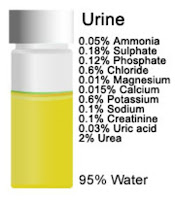Our skin has many functions. It serves as a barrier, protecting the skin from injury, infection and water loss. It also helps to regulate body temperature and eliminate wastes. It produces vitamin D. Finally it helps us gather information about our environment through our sense of touch. Our nails and hair are both part of our skin.
Monday, April 27, 2009
Monday, April 13, 2009
Excretory System
 You've just learned how the kidneys filter blood in the microscopic units called nephron. Wastes such as urea form urine which travels from the kidneys to the urinary bladder by way of the ureters. From the bladder, urine travels through the urethra out of the body. Do other animals produce urine in the same way?
You've just learned how the kidneys filter blood in the microscopic units called nephron. Wastes such as urea form urine which travels from the kidneys to the urinary bladder by way of the ureters. From the bladder, urine travels through the urethra out of the body. Do other animals produce urine in the same way?
Choose any animal and research how that animal filters wastes out of its body. Do they have kidneys or another organ that does the same job?
Tuesday, April 07, 2009
Diseases of the heart and lungs
So far in our Human Body Systems unit, we have studied the skeletal, muscular, digestive, circulatory and respiratory systems. You have learned all about how these systems work when everything functions normally, ie when you're healthy. What happens when something doesn't work right, when you're ill? Find out about one disease or disorder that affects one of these systems. Explain what doesn't work right and how doctor's treat the problem.
Examples - Skeletal: osteoporosis, scoliosos, bone cancer
Muscular: Muscular distrophy, fibromyalgia,
Digestive: stomach ulcers, Krohn's Disease, diverticulitis, stomach cancer
Circulatory: leukemia, anemia, sickle cell anemia, aneurism
Respiratory: Emphysema, lung cancer, bronchitis

Subscribe to:
Comments (Atom)






